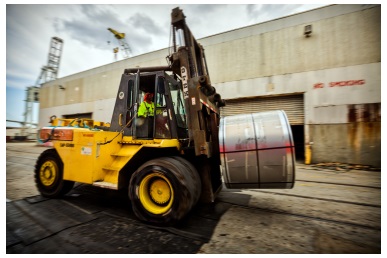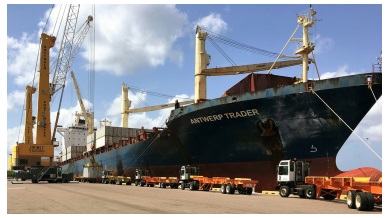Port Traffic Metrics: Georgia, Long Beach, Los Angeles, Manatee, Oakland, Virginia
![]() Print this Article | Send to Colleague
Print this Article | Send to Colleague
Georgia Ports Authority’s Garden City Container Terminal in Savannah had its busiest July ever last month, with throughput up 6.8 percent from a year to 336,099 TEUs. That brought the calendar year total to 2.33 million TEUs, an increase from January-July 2016 of 10.8 percent. Current data suggest Savannah could very well finish the year as the fourth U.S. port to hit the 4.0 million TEU mark.
"It is through the incredible efficiency and productivity of GPA employees and the International Longshoremen's Association -- as well as the continued commitment of shippers and customers -- that these record volumes are possible," said GPA Executive Director Griff Lynch. "Georgia's renewed investments, strong support from Gov. Nathan Deal and state leaders, and superior logistics are encouraging customers to bring more business here."
Other calendar year data through July show cargo crossing GPA docks statewide grew by 13 percent to 20.7 million short tons. In. In July alone, breakbulk cargo rose 12.3 percent to 232,390 tons, thanks to strong performances by state-owned facilities in Savannah and Brunswick.
Lumber handled at Savannah's Ocean Terminal more than doubled in July, to 7,702 tons from 2,366 tons in July 2016, as the construction industry responded to increased demand for single-family and multi-family housing units. Iron and steel shipments also increased at Ocean Terminal, up 10.3 percent to 51,644 tons. Overall, Ocean Terminal's July breakbulk tonnage grew by 22 percent to 124,150 tons.
At East River Terminal in Brunswick, wood pellets exports for use as fuel rebounded from zero last July to 49,011 tons in July 2017, powering 75.7 percent growth in bulk cargo to 68,813 tons.

Workers unload rolls of steel from a vessel at Savannah's Ocean Terminal, where breakbulk cargo tonnage jumped 22 percent last month.
Photo/Georgia Ports Authority, Stephen B. Morton
Long Beach Container Traffic Hit Monthly High in July
Surging traffic made July a record month for container throughput at the Port of Long Beach. July’s 710,312 TEU beat the July 2016 total by 13.1 percent and surpassed by 2.4 percent the port’s previous monthly record, 703,652 TEUs in August 2015.
July also gave the port its fifth consecutive monthly gain, boosting the year total to nearly 4.2 million TEUs and an increase of 6.4 percent compared to January-July 2016.
In detail, the July total reflects increases from last year of 16.3 percent for inbound loads (to a monthly record 378,820 TEUs), an 11.2 percent drop for outbound loads, and a 27.7 percent jump for empty containers. Click here for details.
"These numbers are great for Long Beach and good news for the economy," said Port Executive Director Mario Cordero. "They are also indicators of the kind of service we provide to our customers as they seek the best and most efficient pathways to get their goods to U.S. markets."
Port of Los Angeles TEUs Up 16%, Busiest July Ever
July container volumes at the Port of Los Angeles jumped 16 percent from last year to 796,804 TEUs, making it the busiest July in in the port’s 110-year history.
Seven months into 2017, the container count was 9.5 percent ahead of last year’s, suggesting the port may well shatter the 8.8 million TEU record set in 2016.
The latest data reflect gains from July 2016 of 13 percent for inbound loads, 17 percent for outbound loads and 20 percent for empty containers. The port’s previous July record, 761,326, was set in 2006.
Current and past data container counts for the Port of Los Angeles may be found here.
"As we strive to maintain our competitive edge with these record volumes, it’s important to acknowledge the Pacific Maritime Association and the good men and women of the International Longshore and Warehouse Union who just extended their contract with terminal operators until 2022," said Gene Seroka, the port’s executive director. "The certainty that comes from this decision builds further long-term confidence in our supply chain as we continue to focus on superior infrastructure, innovative leadership and extraordinary customer service."
Port of Oakland Anticipates Five Record Container Traffic Years Starting in 2018
The Port of Oakland is anticipating a five-year run of record container flows, beginning in 1918 and continuing through 2022.
A Strategic Maritime Roadmap released by the port this month predicts Northern California booming freight market will result in growing trade volumes even as vessel calls decline – more cargo on fewer but larger ships. Additional impetus, the report says, should come from new logistics capabilities, such as distribution centers and freight transfer facilities.
"We’re serving a thriving area and developing new services for our customers," said John Driscoll, the port’s maritime director. "The combination should be positive for everyone who relies on the port for their business or their job."
Oakland’s Roadmap includes a commercial strategy for:
- Growing business from local and regional markets
- Remaining the top export gateway for California Central Valley growers
- Increasing U.S. Midwest meat and grain exports
- Attracting containerized cargo to a new refrigerated distribution center and to the 440,000-square-foot first phase of its Seaport Logistics Complex
- Increasing to 15 percent the amount of import cargo that arrives in Oakland and is loaded to the rails for inland distribution
- Attracting more automotive imports
- Making Oakland the first U.S. port of call for at least one vessel service originating in Asia
The Roadmap forecasts record volume of more than 2.4 million cargo containers in 2018, rising to 2.7 million by 2012. The port’s current record, 2.39 million TEUs, was set in 2014.
The port also predicts ships arriving here would be 35 percent larger than today’s average within 15 years. With load capacities of up to 18,000 TEUs, fewer vessels will be needed to handle the forecast record cargo. Fewer ships means fewer diesel exhaust emissions, thus mitigating the environmental impacts of cargo growth.
The port said its new logistics developments will rise near rail lines to reduce the reliance on trucks. That’s expected to further curb diesel emissions.
A summary of the Strategic Maritime Roadmap is available here.
Port Manatee Container Volume Sets Record
Ten months into its fiscal year, Port Manatee is experiencing dramatic growth in container traffic, with throughput skyrocketing to 32,907 TEUs. That’s up 47 percent from last year and in fact exceeds the port’s record full year tally – 30,431 TEUs in FY 2009-10. The 12-month FY 2015/16 count totaled 26,610 TEUs, October/September is the port’s fiscal year.
This year’s jump comes as longtime port tenant Del Monte Fresh Produce NA transitions from breakbulk to containers for transporting bananas and pineapples from Central America. Further impetus, the port says, comes from "the continuing success of World Direct Shipping’s weekly service," which has been bringing Mexican produce to the United States via Port Manatee since November 2014.
During the past year, the port renewed its agreements with Del Monte and World Direct Shipping.
"We are excited to have already set a new container record for Port Manatee and are further encouraged that this favorable trend is anticipated to be sustained for a long time," said Port Executive Director Carlos Buqueras.
The good news is not confined to containers. The port reports cargo overall – bulk and general – increased 17 percent during the first 10 months of the current fiscal year – to 6,438,146 short tons, or just short of 2015-16 fiscal year end total of 6,888,757 tons.
"The dynamic rise in Port Manatee’s cargo activity is striking in and of itself and is further impressive because it translates into growing numbers of family-wage jobs and other positive economic impacts for our community," said Vanessa Baugh, chairwoman of the Manatee County Port Authority.

Discharging containers from a Del Monte Fresh Produce vessel at Port Manatee
Photo/Port Manatee
Virginia: Calendar Year Totals Show Strong Volumes Across All Modes of Transport
The Port of Virginia® reports container throughput at its Hampton Roads terminals totaled 234,230 TEUs in July, an increase of 7.5 percent from last year and its best July performance ever. The year-to-date total of 1,741,560 TEUS was up 8.1 percent compared to January-July 2016, putting the port on course for a second consecutive record year.
Other July data show year/on/year gains for containerized cargo (+4.2 percent), and containers shipped in and out of Hampton Roads by truck (+13.0 percent), barge (+7.4 percent). Higher box counts were also posted by the Richmond Marine Terminal (+5.1 percent) and the Virginia Inland Port (+2.9 percent). Click here to learn more.
"The peak season is underway, we are seeing the large vessels with regularity and handling their corresponding cargo volumes safely and efficiently," said John F. Reinhart, CEO and executive director of the Virginia Port Authority (VPA). "The North Gate at NIT [Norfolk International Terminals] is fully-functional and motor carriers are utilizing that asset more and more, which will be important as we near the start of work this fall on renovating the south-side stack yard at NIT."
The port authority’s board of commissioners recently approved the purchase of four new ship-to-shore cranes for Virginia International Gateway.
Mr. Reinhart notes that the port is beginning to see development of warehouse and distribution space, as evidenced by Panattoni’s recent announcement of a 500,000-square-foot speculative building near Richmond Marine Terminal. Furthermore, he said, "We are continuing to identify new double-stack rail opportunities into the Lehigh Valley and western Pennsylvania."

